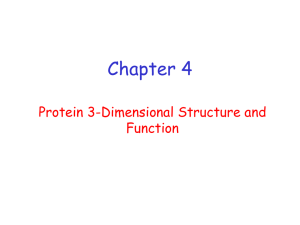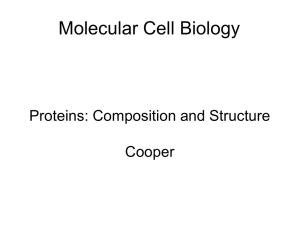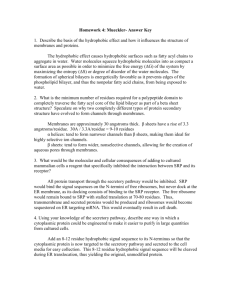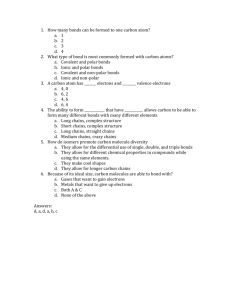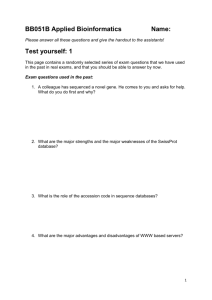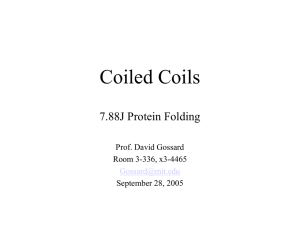Answers-to-exam-in-protein-chemistry-20130315-
advertisement
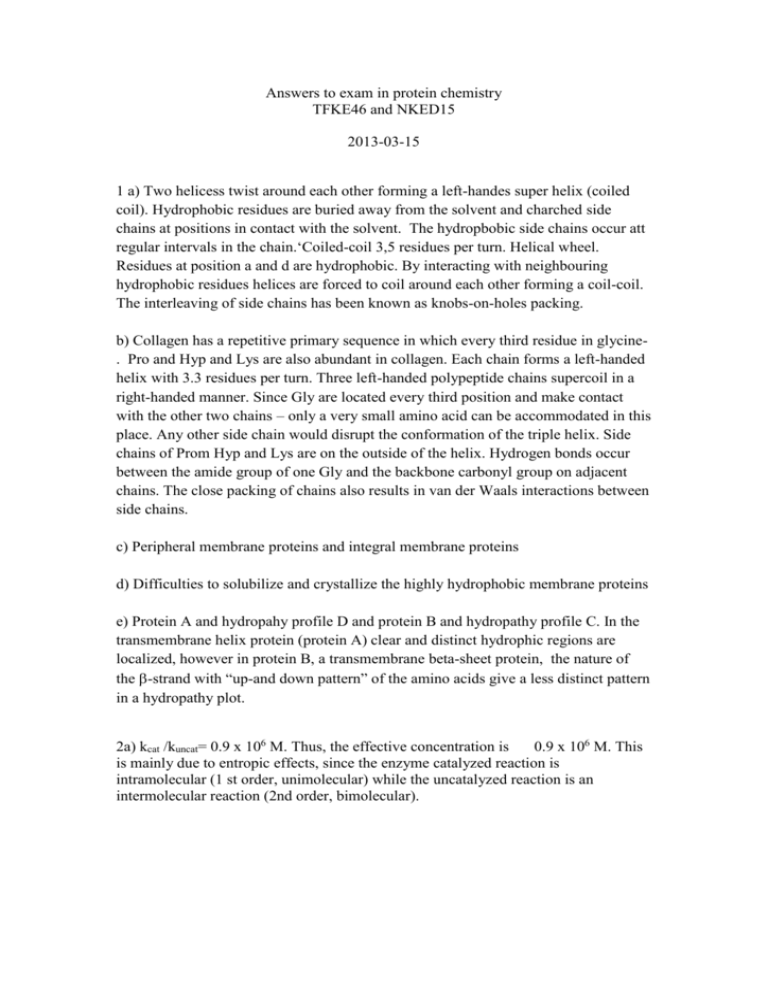
Answers to exam in protein chemistry TFKE46 and NKED15 2013-03-15 1 a) Two helicess twist around each other forming a left-handes super helix (coiled coil). Hydrophobic residues are buried away from the solvent and charched side chains at positions in contact with the solvent. The hydropbobic side chains occur att regular intervals in the chain.‘Coiled-coil 3,5 residues per turn. Helical wheel. Residues at position a and d are hydrophobic. By interacting with neighbouring hydrophobic residues helices are forced to coil around each other forming a coil-coil. The interleaving of side chains has been known as knobs-on-holes packing. b) Collagen has a repetitive primary sequence in which every third residue in glycine. Pro and Hyp and Lys are also abundant in collagen. Each chain forms a left-handed helix with 3.3 residues per turn. Three left-handed polypeptide chains supercoil in a right-handed manner. Since Gly are located every third position and make contact with the other two chains – only a very small amino acid can be accommodated in this place. Any other side chain would disrupt the conformation of the triple helix. Side chains of Prom Hyp and Lys are on the outside of the helix. Hydrogen bonds occur between the amide group of one Gly and the backbone carbonyl group on adjacent chains. The close packing of chains also results in van der Waals interactions between side chains. c) Peripheral membrane proteins and integral membrane proteins d) Difficulties to solubilize and crystallize the highly hydrophobic membrane proteins e) Protein A and hydropahy profile D and protein B and hydropathy profile C. In the transmembrane helix protein (protein A) clear and distinct hydrophic regions are localized, however in protein B, a transmembrane beta-sheet protein, the nature of the -strand with “up-and down pattern” of the amino acids give a less distinct pattern in a hydropathy plot. 2a) kcat /kuncat= 0.9 x 106 M. Thus, the effective concentration is 0.9 x 106 M. This is mainly due to entropic effects, since the enzyme catalyzed reaction is intramolecular (1 st order, unimolecular) while the uncatalyzed reaction is an intermolecular reaction (2nd order, bimolecular). b) See figure c) ΔΔG# = - RT ln (kcat/Km)/kcat/Km) = 4 kcal/mol, equivalent to a strong H-bond from Tyr. 3 a) The favorable binding interactions (ΔH) are counterbalanced by unfavorable loss in conformational entropy upon folding (TΔS). H-bonds stabilizing the native state have to be broken from water interactions upon folding. Therfore, 1 kcal/mol stabilization here is the net stabilization by the H-bond. b) The folding molecule is held one at a time inside the chaperone preventing all interactions with other protein molecules. The molte-globule state is most prone to aggregate, since it has exposed hydrophobic patches. c) The activation energy for this step can be calculated for the pseudowild type and the mutant by determining the rate constants for folding from I to F. Then the difference in activation energy (ΔΔG#) can be obtained. d) The β-turn between β-strands 3 and 4 is already almost completely formed in the transistsion state between U and I (φ is here 83-86%). The β1-strand does not fully adopt its native conformation until after the final transition state (TS(IF); φ is only about 50-60% before). e) The results for the hydrophobic core mutation F20L provide further evidence that the intermediate I has a non-native hydrophobic core, which must be broken up in TS(IF) to allow formation of the native core (φ drops from 73 to 45 % when going from I to transition state). 4) a) Rossman fold b) In the c-terminal end of a topology break i.e. -strand 6 and or -strand 5 and 2 c) The emission spectra have a maximum at approximately 348 nm and 350 nm for native and denatured protein. This indicates that the trp:s are highly exposed both int the native and the denatured state. Therefore to monitor unfolding using Trp fluorescence will only give a small change in wavelength difference. d) The Tm-value is approximately 46 degrees. The Tm –value reflects the loss of bind site(s) for ANS upon increased temperature, probably probing the unfolding of the active site. e) NMR (HSQC), fluorescence and surface plasmon resonance (SPR) f) A Scatchard plot give a Kd= 0.10mM and 1 binding site. A Scatchard plot is of often used to analyze independent binding sites. g) A reasonable explanation for the stabilization is formation of a disulfide bond. Looking in Figure 4B and 4C shows that a possible candidate for disulfide formation is cys212 and cys216 in the neighboring -strand (-strand 8) or cys183 in (-strand 7).
